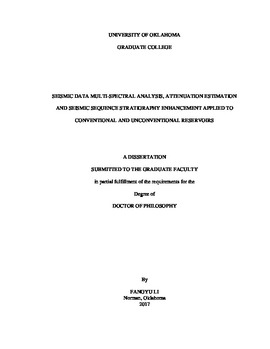| dc.description.abstract | Seismic data are an essential resource for interpretation, providing abundant information about geological structures, sedimentation, stratigraphy and reservoir quality. Geophysicists have dedicated tremendous efforts in fully utilizing the information content in seismic data.
Time series analysis and frequency (spectral) analysis are the two most common tools used to characterize seismic data. Multi-spectral analysis highlights geological features at different scales. The spectral sensitivity is not only from the tuning effects, but also from the geological structures and rock properties, including attenuation. To analyze the additional information in the spectral components rather than in the broad-band data, I begin by examining the spectrally limited coherence responses of multiple stages of incised valleys of Red Fork formation, Anadarko Basin, Oklahoma. Later, I combine covariance matrices for each spectral component, add them together, and compute multi-spectral coherence images.
Spectral ratio and frequency shift methods are traditional attenuation estimation methods. However, the assumptions of each method introduce errors and instabilities into the results. I propose a modified frequency shift method to estimate attenuation (the reciprocal of the quality factor, Q), that relaxes some of these assumptions. Synthetic and field applications show robust and accurate results. Thin-bed layering also modifies the spectra, causing simple attenuation estimation to be inaccurate. To address this limitation, I use well logs based impedance inversion results to calculate a spectral correction for elastic variability in the spectra prior to estimating the inelastic attenuation contribution. The spectral correction can be viewed as a pre-conditioning step, following which both spectral ratio and frequency shift methods can produce better results.
xix
Traditional attenuation estimation methods work well in high porosity and high permeability gas sands. However, the well accepted squirt model does not apply to low permeability shale reservoirs. Rather, micro-cracks generate strong geometric or scattering attenuation, which combined with the intrinsic attenuation produced by TOC (total organic carbon) result in complicated spectral responses. Rather than estimating Q, I evaluate a suite of attenuation attributes. Even though the mechanism underlying may be unknown, these attenuation attributes can be statistically linked to the production and geology.
Using the classic Fourier transform, the available spectral band often falls between 10 and 80 Hz. Nevertheless, interpreters observe lower frequency patterns in the data, for example, a 200 ms thick (5 Hz) pattern of low reflectivity sandstone and a 400 ms thick (2.5 Hz) pattern of high reflectivity responses (e.g. sabkhas or cyclothems). I introduce an adaptive intrinsic mode decomposition method called variational mode decomposition to analyze the “rhythm” in the seismic data. The intrinsic modes are defined as combinations of AM modulated signals, which are analyzed in the frequency domain with carrier frequencies (that fall within the 10-80 Hz limit), to characterize the buried stratigraphy information seen in the longer wavelength patterns. Because intrinsic modes are able to model seismic signals, but unable to model the noise component, the random noise lies within the residual of the intrinsic mode decomposition. Unlike filtering methods with predefined parameters, I develop a fully data-driven denoising method to suppress random noise, thereby enhancing the data quality. | en_US |
